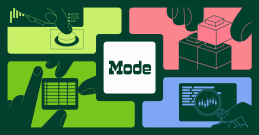Why Centralize Data?
Jenn Daugherty, Senior Content Marketing Manager
January 3, 2023
NaN minute read

Centralizing data in an organization helps reduce redundancies, acts as a single source of truth, and accelerates the ROI of data tools and campaigns across the organization.
There are two ways to interpret the idea of centralized data—one is the technical position of your data warehouse and whether different data sources are feeding into an, often cloud-based, warehouse—and the other is the concept of a centralized data team within a company and the accessibility of the data being used across the company to propel business decisions.
Both concepts of centralized data are important and should be used to streamline data and optimize business processes. In this article, we’ll talk about why companies should centralize their data teams to foster more data-driven decisions throughout their organization. Let’s start by unpacking what centralizing data means.
What is centralized data?
Centralized data starts with housing all of your data from different sources in a cloud-data warehouse. This can then serve as the central location to collect all of the organization's incoming data. Examples of cloud data warehouses include Redshift, BigQuery and Snowflake.
Download our Modern Data Stack Guide to learn more about cloud data warehouse options.
From the warehouse, data can then continue to be centralized in a BI platform like Mode for advanced analysis. When the entire company can do data analysis in a platform that acts as a single source of truth, it eliminates discrepancy in and duplication of data, while increasing access to data and data adoption in all areas of business. An efficient, cost-effective centralized data strategy does more than monitor KPIs, it’s a part of modern business management and is strategic for growth across the company.

Mode for Startups
Grow your startup without having to worry about outgrowing your analytics platform.
How can I benefit from centralized data?
The benefits to centralized data in an organization are myriad. Centralized data can reduce cost, increase data culture, and help increase the organization’s collective knowledge. 1. Reducing cost
One thing every company tries to reduce is cost. Bad data costs money and can come from inaccurate reporting, outdated analysis, poorly configured KPIs, or data not being synced to the data warehouse. The effects of bad data can keep a company from very real or very needed growth. There can be lost revenue, ineffective campaigns being pushed, an increase in churn, a decrease in sale size - all from “bad” or decentralized data.
A modern data stack built around centralized data teams can reduce costs. Having one platform simplifies your data stack while integrating with apps across the ecosystem that you use to run your business. For example, Mode has analytical tools for analysts—offering SQL, R, and Python support—while also offering self-serve reporting and clean visualizations for business teams, eliminating the need for many costly, siloed tools, and bringing you closer to a data-centered structure. 2. Increasing data culture
Having a single source of truth for your data can not only reduce costly errors, but can increase your data integrity both literally and in the minds of your team members. When teams trust the data they’re using, businesses thrive. Curated Datasets and organized reports instill confidence in users less familiar with data, giving them a starting point for initial analysis while data team members can dive deeper with ad hoc analysis. Embedding reports in everyday business tools also reinforces the reach of insights available from company data, resulting in data-based decisions by teams who previously felt too far from data. 3. Increasing speed-to-insight
Having centrally-managed data can also create simplified reporting which can increase time-to-insights across an organization. When analysts and data scientists can manage data, create SQL queries, and use Python and R notebooks in the same tool that business users can access for reporting, both teams can access trustworthy analysis faster. Analysts minimize redundant exporting or transfer of reports and business teams are not removed from the data process, thus increasing data literacy, curiosity, and trust.
When stakeholders have the ability to create multi-faceted, multi-layered visualizations with ease, challenging questions can be answered openly and quickly— - leading to accelerated business growth. 4. Building collective intelligence with cross-functional insight
The ultimate goal of this unified, centralized data structure is to uplevel decision-making at every level of the company. And with a modern BI tool, data teams can deliver higher impact and increased data maturity for businesses across all sectors and stages. With everyone building off of analytics in the same tool, collective intelligence will increase across an organization.
Download now

How to Lead from The Center: A Guide for Data Leaders
Learn how to unlock a trusted data experience across your org.
How can I move to a centralized data model?
The shift to a data-centric organizational structure is not difficult to accomplish. Mode has found that our customers have come to this type of centralized data structure organically after using Mode. Whether coming to this new organization organically or systematically, there are a few ways to get the best results from your efforts.
A centralized data team
It’s not uncommon for data teams to operate under the product or engineering teams, annexed from the pulse of daily problem solving. But, when they sit under a more central function of the business, like strategy or finance, they are well-positioned to work on more central analysis of high-priority goals and generate more relevant, impactful analysis for the organization. To maintain a centralized data team, the cross-collaboration of data analysts with business teams is crucial. As business teams become more data-focused and dive deeper into KPI reporting, it is useful for organizations to create 1:1 analyst-business team partnerships.
With a dedicated analyst working with a specific team like marketing or finance, the analyst can develop a closer relationship with that team, the metrics they’re searching for, and better understand the larger business goals they are trying to achieve. Instead of the round-robin approach of a data ticketing system, developing these partnerships enhances the level of analysis that can be achieved, the efficiency in dataset and report creation, and the speed from queries to answers to results.
Data accountability and ownership
As with anything new or changing in an organization, knowing who’s accountable and what the chain of command is, is important. Centralizing data gives ownership to all business groups; each team can be in charge of their data and the decisions they are able to make because of it. When everyone has a seat at the data table, everyone can create faster insights by diving deeper into their reports. We’ve heard from multiple Sr. Data Managers or Heads of Data who have put data at the center of their businesses that they don’t view data as the sole property of the data team, but the property of each team to explore and use. The goals of these data leaders are to move collaboration upstream and help finance, product—any teams—understand that it’s their data, it’s their skin in the game to make the best business decisions with.
Socialization
Socialization might seem like the cherry on top of the centralized data sundae, but it’s really the bowl holding it all together. While having data in a single, secure, accessible location for analysts and business users alike able to access it, unless reports are created, shared, incorporated into everyday processes, a culture of data at the center of business decisions won’t take hold. So in order to make everything work, there must be socialization and adoption of all this wonderful data and analysis. This might mean embedded reports into the most common tools that business teams use, automated reports sent to emails or Slack channels, or consistent cross-functional meetings to highlight key takeaways from recent reports to bring visibility.
The caveat emptor here is to not create other, smaller silos for data within your socialization plan. The right data should be available to the right people, reports shared, summarized, and socialized to the highest levels of the organization to be acted on. If reports linger within the teams creating them, the value that data is providing gets stymied. Create a process for data revelations to be surfaced company-wide and data will become the area your organization centers around.
The case for centralized data - Imperfect Foods
Imperfect Foods is a weekly grocery delivery service whose goal is to minimize waste and increase sustainability. Imperfect Foods is also a Mode customer and a data-first company, that creates efficiency in the food system while also creating thousands of personalized orders for delivery every week. They are also a great example of what centralized data looks like in action from a tooling perspective (with a modern data stack) and cultural perspective.
When their Analytics Manager, Adam Smith, first started, the data team was operating under the product team. They now report to finance and strategy which allows them to play a much bigger role than they could by only reporting to the technology team.
With this new structure, they also moved to having a dedicated analyst for marketing, finance, and the product team, etc. As a result of the new analyst-business team pairings, Smith is seeing that business teams are reaching out to the data person as soon as they start thinking about a new initiative, instead of at the end of a project, which is helping each project have better data.
"Stakeholders feel like they’re more involved in the process and getting data in a way that’s most useful to them. They’re also seeing that the highest value work is getting done."
After seeing tangible results from their data-backed approach, Imperfect Foods made sure to highlight that these wins were surfaced and actualized through the use of data to detect problems and optimize their successes.
What features optimize central data sharing?
To get the most out of a centralized data model, where analysts can access data quickly and business users can quickly explore and build upon reports, certain features are a must. Data Visualization and Exploration
Data exploration is the way to gain deeper insights for your business. Ad hoc analysis tools allow you to dive deeper into high-impact data and give the flexibility to slice and share data with ease.
Part of that analysis is visual exploration. Business users want to see charts, trends, usage, etc. Being able to work with data in a visual way without breaking the backend is what allows business teams to get results more quickly with reports and fine tune them to their needs. Datasets Datasets open up a whole new, streamlined world for both sides of the data equation. Mode currently has Datasets. By creating verified, reusable building blocks to distribute to teams throughout your business, teams can create their own reports, set run schedules, and deeply trust that dashboards are always up to date. On the analyst side, datasets reduce database load and reduce repetitive requests for the same data over and over again.
Centralized data teams power the reports pulled in self-serve reporting. Empowering teams to answer their own questions, add commentary, and filter their own data is the end state of an optimized data stack and data team. Embedded analytics
Embedded analytics make presenting data a breeze. Customized styles make reports look on brand while access to top charts and customized visualizations allow users to quickly access and analyze their data.
Operating in a data-centered environment
A scalable, flexible central data structure will benefit you long term and should be able to adjust in an agile way to the needs of your teams. Creating a modern data stack that uses best practices for raw data, ingestion, warehousing, and transformation is necessary. Using a modern BI tool will bring your data to life to everyone in your organization with accuracy, security, and speed will create teams that understand data, use it throughout their processes, and value a data-first culture. As you scale, seamlessly integrate with new tools, create advanced, custom reporting, and analyze more data without overloading the data warehouse.
Reframing data as a central component for improved decision-making, operational efficiency, and team collaboration separates today’s leading companies from the pack.
Meet Mode, modern BI
Mode is modern BI built around data teams. Mode tools are created and optimized for collaboration at every level. Our integrated Python and R notebooks, SQL Editor, Datasets, and dbt Semantic layer integration focus on delivering tools that data analysts need. Our Visual Explorer, Embedded Analytics, and self-serve reporting features, to name a few, are built to empower business users to own their data and reduce time to insight, making strategic business goals easier to accomplish and backed by data.
Mode maximizes modern data stack ROI and turns data into a competitive advantage for leading businesses across all sectors and stages. To learn more about leading from the (data) center, read our whitepaper for data leaders on how to turn your data into a competitive advantage.

Mode's Live Weekly Demo
Join our group demo to get a communal walk-through of Mode!
Get our weekly data newsletter
Work-related distractions for data enthusiasts.




